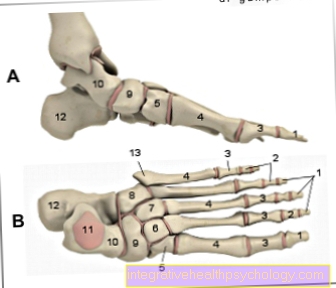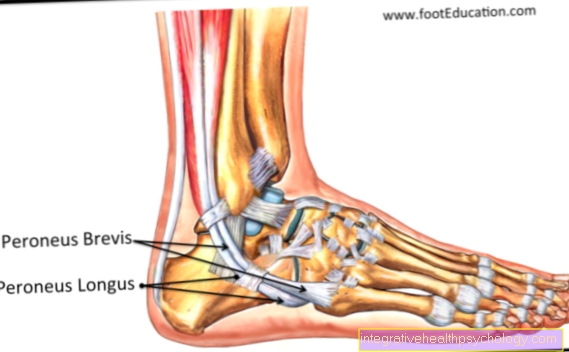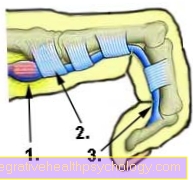Amputation of a finger
definition
A finger amputation is the separation of a finger from the body, for example as a result of an accident. Depending on which finger is affected and at what level the amputation occurs, there is a risk of functional impairment of the hand.
In some cases, hand surgery can be used to sew the finger back on and, if necessary, regain its function. The procedure is called reimplantation. Otherwise, surgical treatment of the remaining stump is carried out so that it can heal.

Causes of the amputation of a finger
By far the most common cause of a finger amputation is an accident. Both work and leisure accidents can lead to the loss of a finger. You can differentiate between cuts, for example, caused by a saw, knife or scissors, and crush injuries, for example caused by being trapped in a machine. Accidents in traffic can also lead to the amputation of a finger.
Rarer causes of a finger amputation are diseases that lead to non-healing wounds on the fingers. It is often a circulatory disorder due to a vascular disease. The amputation - in such a case the planned surgical removal of a finger - represents the last remaining therapeutic measure if there is no prospect of a cure and the finger otherwise poses an inflammation risk for the entire body.
also read: Causes of an amputation
Indication for amputation of a finger
For the indication of an amputation of a finger, the examination of the patient (possibly finger stump and severed finger) as well as the medical questioning about the circumstances of the accident are decisive. It is also important to indicate possible concomitant diseases such as diabetes (“diabetes”), which can have an influence on wound healing. With a trained look and a close look at the injured finger, the doctor can estimate the extent of the injury.
If necessary, he or she will have an X-ray of the hand made to assess the impairment of the bony structures. The measures mentioned are usually sufficient for a precise diagnosis.
If a surgical procedure is to be carried out to supply and possibly restore the hand, the doctor will also draw blood. In most cases, further diagnostic measures such as CT or MRI are not required. As soon as the diagnosis has been made, prompt therapy, usually through an operation in a hand surgery clinic, is decisive.
You can also find out more at: Amputation - you should know that!
Accompanying symptoms in an amputated finger
When an accidental finger amputation occurs, the primary symptom is pain on the remaining finger stump. Accompanying symptoms can also be swelling of the hand and heavy bleeding. In addition, many people react to the usually shocking sight of the bloodied and disfigured hand as well as to the pain with other symptoms such as tremors, sweating, circulatory disorders and even fainting. Panic and feelings of fear can also appear as accompanying symptoms.
Accompanying persons should therefore try to stop the bleeding with a simple pressure bandage and also try to calm the patient down until medical care is possible.
If the amputation of a finger is not the result of an accident but the goal of an operation, for example in the case of a circulatory disorder, the affected finger may feel numb as an accompanying symptom before the operation.
After a finger amputation of any kind, a functional limitation of the hand is in the foreground. This is usually most pronounced when the thumb or index finger is lost.With all other fingers, if only one finger is amputated, the gripping function can mostly be retained as far as possible.
As with any amputation, however, so-called phantom pain can occur after a while. This means that pain signals from the finger that is no longer present are transmitted via the nerve tracts. The fingers hurt even though he is no longer there.
Find out more at: Phantom pain
Pain
Accidental amputation of a finger is usually very painful. Most patients initially describe the pain as sharp and light. After a while, the character of the pain changes frequently. The pain is then more throbbing and dull. Depending on the extent of the injury, the pain can also radiate to the hand or forearm.
As soon as a doctor is on site, he or she can give the patient painkillers, which usually significantly alleviate the symptoms. Even after the intervention, the hand usually still causes pain, but this can and should also be treated with painkillers.
That might be interesting for you too: Painkillers- You should know that!
Preparation for the amputation of the finger
With a finger amputation, good preparation is crucial in order to treat the patient as well as possible and, in the best case, to preserve the finger. If the finger is lost in an accident, the wound should be treated with a pressure bandage as quickly as possible so that blood loss is kept to a minimum and the tissue swells as little as possible. The injured person should also hold up the affected hand a little.
You should also find the severed finger and put it in a clean plastic bag. This bag is ideally placed in another plastic bag that is filled with water and some ice. It is now crucial to bring the patient and the severed finger as quickly as possible to a hand surgery clinic so that an attempt can be made to sew the amputated finger back on.
The preparation for the actual procedure consists in the fact that the patient is given analgesic and numbing medication and the wound is cleaned.
Performing the finger amputation
If a finger is amputated as a result of an accident, an attempt is usually made to sew the severed finger back on with an operation. First the bones are put together and fixed. Next, the surgeon has to sew the flexor tendons, blood-supplying arteries and nerve tracts together. This is followed by the suturing of the blood-draining veins and the extensors. Finally, the skin is closed. The intervention can only be successful in the long term if all the structures mentioned heal again.
If there is no prospect from the outset that the finger can be sewn on again and heal if the tissue is too damaged, smooth wound edges are created on the various structures (bones, tendons) and the wound is closed so that a stump remains.
One possibility, if a ring or index finger is lost, for example, is to move the little finger to the appropriate position in order to achieve the least possible functional impairment of the hand. In any case, medication must be taken after the procedure, wound checks performed and functional exercises performed.
Learn more at: Amputation technique
Follow-up care for a finger amputation
After a finger amputation, follow-up care consists of regular wound control in order to identify possible wound healing disorders in good time. In addition, after a finger is sewn back on, it must be examined whether the procedure was successful and whether all the necessary structures such as blood vessels and nerves are growing together again and are starting to function.
Careful movement exercises are carried out in the further course. However, if the finger could not be sutured again and only a stump remains, follow-up care will differ. Although the most important goal here is uncomplicated wound healing, in the course of the process, the possible provision of a prosthesis may become the goal of aftercare. An important requirement for this is that the stump can heal as well as possible. Special pressure associations are regularly created for this purpose.
How long does it take to heal with amputation of the finger?
A general statement on how long it will take to heal after a finger amputation cannot be made. This depends on many different factors, such as the cause of the amputation, the age of the patient and possible concomitant diseases (such as vascular diseases or diabetes). For smokers, the healing time is also longer and the risk of complications is increased.
In addition, the duration of the healing depends to a large extent on which procedure was necessary and how well it went. The externally visible wounds are often already healed after a few weeks (more or less large scars may remain). However, it can take significantly longer (several months) for the finger and hand to heal completely until normal function of the finger and hand is restored.
In many cases, functional restrictions also remain, even if the finger has been successfully sewn on again. This can be indicated by abnormal sensations such as tingling, feeling cold or restricted mobility of the affected finger.
Are there finger prostheses?
There are basically finger prostheses that can only be used under certain circumstances after a finger amputation. The most important requirement is that the stump has healed. In addition, it must be ensured that the circumference and volume of the residual limb are stable for a reliable prosthesis. If the stump occasionally swells, for example due to water retention, it is often not possible to insert a prosthesis.
An orthopedic technician should be consulted to clarify the question of whether a finger prosthesis is an option. If a finger prosthesis is possible, this is then individually adapted and serves as an aid. However, the complex function of the entire hand can never be completely restored, so that one has to live with limitations even with a finger prosthesis.
Find out more at: Prosthesis supply
Degree of disability after a finger amputation
A degree of disability can be assigned by a finger amputation. The amount depends on how many and which or which fingers are affected. If an index, middle, ring or little finger is affected, the degree of disability is 10%. The loss of the thumb results in a degree of disability of 25%.
If several fingers are lost as a result of the amputation, the degree can be significantly higher, especially if both hands are affected.
In extreme cases, the loss of all fingers in both hands can even result in a degree of disability of 100%. The prerequisite for the numbers mentioned is that the finger (s) are irrevocably lost and have not been successfully sutured again after an amputation. In addition, these are only guidelines and the degree of disability of a person is determined individually based on their limitations.
Amputation of the fingertip
An amputation can basically take place in different areas, the so-called amputation heights. The aim is always to remove as much tissue as necessary and as little as possible.
In the case of a finger amputation, the amputation of only the fingertip represents the smallest possible extent. In addition, an injury, for example through a cut or a bruise, can only lead to the loss of the fingertip, which is also referred to as amputation. With timely medical care, the dome can be sewn on again if necessary. The chances that the fingertip will grow back with a smooth cut and otherwise minor tissue damage are better than, for example, with a crush injury with severe deformation of the body part. If there are no tendon injuries, the severed fingertip can grow back on in some cases with a special film bandage.
Editor's recommendations
You might also be interested in:
- Amputation - you should know that!
- Causes of an amputation
- Amputation technique
- Prosthesis supply
- Phantom pain





























